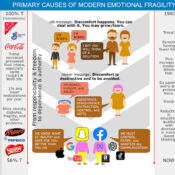Excerpt from the “A Practical EmPath” system by Scott Howard Swain. Originally written in September 2022.
Permissive <> Practical <> Authoritarian
A friend came to visit the other day. Let’s call her Jane. She complained some that she was really glad to have somehow found the time to herself away from her 12-year old daughter. This was not a new issue for her. I’d known Jane since before she had become a mom.
Over the years, I noticed that – at least in my presence – she always put her daughter’s needs first. It was frustrating hanging out with Jane when her daughter was around because the child interrupted constantly and the mother always felt compelled to give the daughter her attention, no matter the situation.
Back to her visit the other day. I asked Jane, “When do your needs come first?” It gave her pause. I left it at that, hoping she thinks more later on the issue.
Parenting can be the most challenging of responsibilities. We want so much for our children and sometimes they want more from us than we can realistically give. Balancing our own needs with theirs can be difficult and lead to conflict. We want to meet their needs while
(a) preparing them for the real world; and
(b) without sacrificing our own needs to the point where our energy and patience run dry and our treatment of the child deteriorates.
Not easy! Especially because every child is different. My hope is that you will find answers or at least clues in the following examples.
Example of passive use of natural consequences
Using “passive consequences” requires the least amount of work on a parent’s part. It usually involves merely allowing a child to reap the consequences of their actions. Most of the time it is “holding back” from helping or rescuing the child from a painful or risky experience that is not necessarily going to damage to the child. Sometimes it can be difficult to distinguish between just how likely their activity will lead to health-threatening damage vs resilience-building stressors. If you are unsure, in the name of safety, do interfere. Hopefully, you can find a minimal level of interference, like a gentle suggestion, that can create a “soft guardrail” for your child.
Note: I’m borrowing some from Becky Bailey’s Conscious Discipline and Marshall Rosenberg’s Nonviolent Communication.

Little Susie is about to go out into cold/wet weather, maybe to walk to the bus stop. Parent wants to protect her from the consequences to her health by encouraging or forcing Susie to wear more weather-appropriate clothing. If the parent gives in to these feelings, we have pros and cons:
Pros
– Peace of mind and vicarious comfort for you.
– Meets your needs for safety/security, support, nurturing, meaning, and purpose.
– Meets your child’s need for near future comfort; as soon as they go out and feel the cold/rain/snow.
– Meets your child’s need for health*.
*Saved from potential negative health impact. Potential because the natural consequences approach will usually result in the child solving the issue on their own after minimum exposure to the inclement weather.
Cons
– Encourages dependency in both directions. (a) Your child is denied the opportunity to creatively problem solve. (b) The parent can become addicted to the “rescuing”, which meets needs for safety/security (for your child), support, nurturing, meaning, and purpose.
– Every time you dictate behavior, it has the potential to negatively impact the relationship. Of course, at certain ages and in certain situations, it’s difficult if not impossible to avoid dictating, but with enough thought, coercion can be significantly reduced, as we’ll see in other examples.
– The more time and energy you put into assisting, controlling, or protecting your child, the less time and energy you have to meet your own needs, which impacts all your relationships, including your parenting.
Example of active use of natural consequences
Using “active consequences” requires parents taking action to create a consequence, ideally tying the consequence as closely to the objectionable behavior as possible. It may not always be possible but striving for it can be beneficial because, when it works, it helps create a link in the child’s mind to the consequences of their actions. “You do X, you get Y.” Building, via reputation, a deeper understanding of response-ability.

Johnny is making a noise that is annoying, disruptive, or distracting. This includes asking for attention verbally or pushing, pulling, or striking you. You are in the middle of talking with someone else in person or on the phone. Note: I’m not talking about emergency situations where Johnny’s health is an issue.
First, of course, comes practicing our super power of empathy by guessing what needs Johnny is trying to get met. Let’s say it’s to be seen/heard. And what about your needs? They are just as important. In this situation they could be respect, consideration, and to be heard as well.
At some point, hopefully, before this event occurred, you would have explained to Johnny how sometimes people’s needs come into conflict. The conversation might look like this:
“Johnny, sometimes you might have a need to be heard and you want me to help you with your need. I always want to help you with your need! Sometimes, though, my needs may make it difficult to help you with yours. That’s where you get to exercise your ability to meet your own needs or find someone else to help you meet them. What comes up for you when you hear this? What do you hear me saying?”
Now, this conversation is going to be highly dependent upon many factors, including especially, the relationship you have built so far with Johnny, his age, and more. This is usually a conversation you will want to have set aside time for. Pre-planning this conversation will allow you to come up with some examples. Be sure to ask Johnny for feedback often during this conversation.
Is the visitor/phone call situation conducive for you to take the time to empathize with Johnny out loud? “Johnny are you feeling frustrated because you really want to be seen and heard?” If you are on the phone, depending on many factors, you may want to use silent empathy with a look of empathy on your face, placing your palm on your heart, and nodding at Johnny. Optimally, you have established the kind of relationship with him that he “gets” it.
But parenting is not always easy, so let’s go with the non-optimal happening. Maybe Johnny is tired, hungry, or just having a bad day.
You have (a) empathized with Johnny’s needs silently or out loud to him and (b) calmly conveyed to him how the behavior impacts you and yet, he continues the disruptive behavior, ignoring your needs. At this point, some parents might immediately yell, spank, or grab the kid and forcibly move them to another room.
Is the situation conducive for you to take the time to empathize with Johnny out loud? “Johnny are you feeling frustrated because you really want to be seen and heard?” Since you are on the phone, depending on many factors, you may want to use silent empathy with a look of empathy on your face and placing your palm on your heart and nodding at Johnny. Optimally, you have established the kind of relationship with him that he “gets” it.
But parenting is not always easy, so let’s go with the non-optimal happening. Maybe Johnny is tired, hungry, or just having a bad day.
You have (a) empathized with Johnny’s needs silently or out loud to him and (b) calmly conveyed to him how the behavior impacts you and yet, he continues the behavior. At this point, if he continues the behavior, some parents might immediately yell, spank, or grab the kid and forcibly move them to another room.
Sure, those are examples of “active consequences,” using the most direct and easy approach. But what if you are a parent who wants to reserve coercion only as a last resort?
For the purposes of this example, we’ll assume Johnny’s physiological health is not in danger and you have tried to empathize with him.
Remove yourself from the area
If you have a space you can go to in order to get the quiet and peace you need to continue your phone conversation free of interruption, use that area.
Now, if the child follows you and either makes disruptive noise at the door or refuses to stay outside the room, there is no other person available to handle Johnny’s needs at the time, and you can not take a few moments from your phone call to give Johnny your full attention, then it may be time to create some more extreme active consequences for Johnny’s actions.
The last resort
“In the event of an emergency, put on your own oxygen mask first and then your child’s.”
Let’s take a look at your goals:
– Get your needs met.
– Get Johnny’s needs met.
Now your issues:
– You want to empathize with Johnny
– You worry that allowing Johnny’s needs to trump yours can send reinforce an attitude that will not serve either of you in the future.
What is parental coercion?
Let’s get clear now on what coercion is in terms of parenting. I assert the following:
– Consider the property where the behavior is occurring. Is it in the home you pay for? Is it in the car you pay for? Most people understand why respecting property rights is important, so I’ll assume we share that understanding.
– What are a parent’s obligations to their children? I assert: Keep them safe and healthy. I also assert that it is not a parent’s obligation to “make their child happy”. I want to be clear. A parent can choose to contribute to a child’s happiness, but it is important to understand it is a choice. I prefer to support the child in a way where they are capable of generating and sustaining their own happiness.
Now that we got those two points out of the way, I wonder if you can see where I’m going with this? Pause to think about it a moment, if you like.
Continuing the example
You are on the phone with a friend or client. Johnny is screaming. You give a hand signal and/or a facial expression expressing to Johnny this is not desired or acceptable behavior. Optimally, you have enough of Johnny’s respect from previous interactions that the gesture works. Let’s say it did not.
You tell the person on the other end of the phone you will call them right back. You hang up and give Johnny a stern look, while saying in calm voice, “Johnny I understand you may have a need to be seen and heard. I want to meet that need for you. I also have needs. When I was talking on the phone just now, and you interrupted, I had a need for consideration and patience not getting met. I signaled you that I’m annoyed and frustrated with your behavior. I will give you a choice: You stop now and wait for me to be available for you or I will put you in another room where you will not be able to disrupt my conversation.
At this point we are at a cross-road. If Johnny complies, you can breathe a sigh of relief and get back to your conversation. But let’s say he continues the behavior or even escalates. This is where you, in/on your own property and under no obligation to “make the child happy,” will, calm-but-firmly, say “Go to your room now.” If he still does not comply, you are fully within your rights to physically (gently as possible) move him to his room and even using the lock on the outside of the door if necessary.
“But it could be a little thing to pause my conversation and give Johnnie the attention he craves.”
For now, consider what kind of person you want your child to become, both in your home and later in life when they venture out on their own. More on this later.
Some of you who are more creative may look for holes in this approach and maybe you will find some. Now, before you go far into that, I request you put on your “common sense” hat.
<Trigger Warning>
Here are some “fun” examples that all begin with “What if you lock him in a room and…”
– Your phone electrocutes you to death and no one else lives there, so the child is locked in his room and starves to death?”
– A sniper shoots you through the window, so Johnny eventually figures out how to break his bedroom window, but then bleeds to death from getting cut on the glass or breaks his neck falling out the window?
– An airplane falls out of the sky and hits your house at an angle where it kills you but leaves the kid to starve to death or roast in the flames from the burning wreck?
– An earthquake…
Yes, we can dream up all kinds of horrendous not-so-common scenarios to justify either beating our kids or passively letting them rule the house instead of taking the time to try reason and then use as gentle coercion as possible.
That all said, there are endless debates about whether children are to be considered “property” of their parents and thus supporting an idea that parents are morally correct to do anything they choose to their children, including violence far more harsh than I’ve spoken of her and maybe even choosing not to abide by the obligations to their children’s health that I asserted above. I’m not interested in those debates, as I see it as sufficient to use the methodologies and justifications I outlined above.
If the parent instead stops their phone conversation to try to work with the child, meet their needs to be seen/heard in that moment, here are some potential negative consequences to them and their relationship:
– “I can interrupt whenever I want and I will get what I want immediately. I need not exercise patience, consideration, or self-control.”
– “If I demand, annoy, or make others uncomfortable enough, I get what I want.”
– “My feelings and needs are more important than anyone else’s, especially mom and dad.”
Notes
– I know many of you will choose to judge the “lock them in a room” as overly harsh. I know it may sound that way and even overly coercive to restrict their freedom of movement. I’ll remind you that they are in/on your property. Also, there are measures you can take to increase the safety of the area they are being restricted to.
– Finally, if you look closely at the examples above, you will find clarity and empathy.
Want more? Check out these articles
Teaching and parenting with empathy: https://clearsayarchive.com/example-using-empathy-with-kids.html
NOTE: Some of the above articles are in queue to be moved to this site, so please excuse the mess.
Some books I recommend on this topic
Nonviolent Communication by Marshall Rosenberg
the “A Practical EmPath” system by Scott Howard Swain (read chapter by chapter excerpts here)
Easy To Love, Difficult to Discipline: The 7 Basic Skills for Turning Conflict by Becky Bailey
Conscious Discipline: 7 Basic Skills for Brain Smart Classroom Management by Becky Bailey
Everything Voluntary from Politics to Parenting by Skyler Collins
Punished by Rewards by Alfie Kohn
How Children Learn by John Holt










Recent Comments